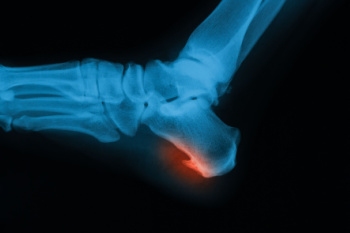
Wilmington (937) 382-2347
Fax
(513) 932-1606

Wilmington (937) 382-2347
Fax
(513) 932-1606
 Cuboid syndrome is a condition where the cuboid bone in the foot becomes partially dislocated or misaligned, causing pain and discomfort. It often results from an injury or overuse, particularly in athletes or individuals who engage in activities involving repetitive stress on the feet, such as running or jumping. Symptoms include pain on the lateral side of the foot, difficulty walking, and swelling or tenderness surrounding the cuboid bone. Diagnosis is typically made through physical examination and medical history, as it may not always appear on standard imaging tests. Treatment involves realigning the cuboid bone, which can be done through manipulation techniques performed by a podiatrist. Additional treatments can include rest, compression, elevation, and supportive footwear, or orthotics to alleviate stress on the affected area. If you have pain on the lateral side of your foot, it is suggested that you schedule an appointment with a podiatrist for a proper diagnosis and treatment.
Cuboid syndrome is a condition where the cuboid bone in the foot becomes partially dislocated or misaligned, causing pain and discomfort. It often results from an injury or overuse, particularly in athletes or individuals who engage in activities involving repetitive stress on the feet, such as running or jumping. Symptoms include pain on the lateral side of the foot, difficulty walking, and swelling or tenderness surrounding the cuboid bone. Diagnosis is typically made through physical examination and medical history, as it may not always appear on standard imaging tests. Treatment involves realigning the cuboid bone, which can be done through manipulation techniques performed by a podiatrist. Additional treatments can include rest, compression, elevation, and supportive footwear, or orthotics to alleviate stress on the affected area. If you have pain on the lateral side of your foot, it is suggested that you schedule an appointment with a podiatrist for a proper diagnosis and treatment.
Cuboid syndrome, also known as cuboid subluxation, occurs when the joints and ligaments near the cuboid bone in the foot become torn. If you have cuboid syndrome, consult with Dr. Gerald Perelman from Ohio. Our doctor will assess your condition and provide you with quality foot and ankle treatment.
Cuboid syndrome is a common cause of lateral foot pain, which is pain on the outside of the foot. The condition may happen suddenly due to an ankle sprain, or it may develop slowly overtime from repetitive tension through the bone and surrounding structures.
Causes
The most common causes of cuboid syndrome include:
Symptoms
A common symptom of cuboid syndrome is pain along the outside of the foot which can be felt in the ankle and toes. This pain may create walking difficulties and may cause those with the condition to walk with a limp.
Diagnosis
Diagnosis of cuboid syndrome is often difficult, and it is often misdiagnosed. X-rays, MRIs and CT scans often fail to properly show the cuboid subluxation. Although there isn’t a specific test used to diagnose cuboid syndrome, your podiatrist will usually check if pain is felt while pressing firmly on the cuboid bone of your foot.
Treatment
Just as the range of causes varies widely, so do treatments. Some more common treatments are ice therapy, rest, exercise, taping, and orthotics.
If you have any questions, please feel free to contact our office located in Wilmington, OH . We offer the newest diagnostic and treatment technologies for all your foot care needs.